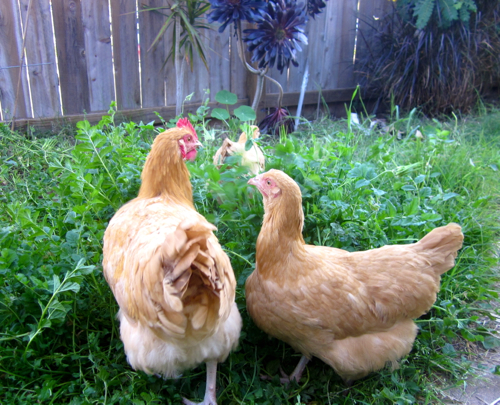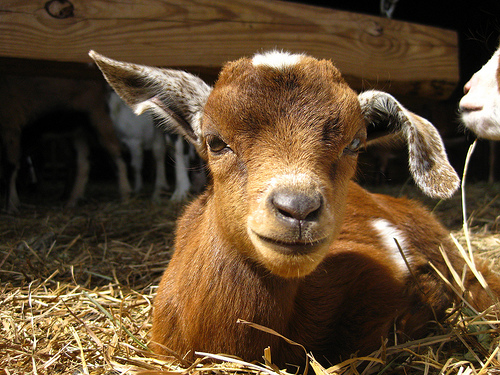 The right to keep dwarf or miniature goats in your backyard is just one of the changes being promised in San Diego’s new urban agriculture ordinance.Photo: robotikaSan Diego resident Adam Hiner is hoping to get his chickens back. Adam and his sister were keeping hens too close to their house (breaking the city’s law that requires owners to keep them a full 50 feet from any residence) when a neighbor complained, and he had to give the birds to friends and family.
The right to keep dwarf or miniature goats in your backyard is just one of the changes being promised in San Diego’s new urban agriculture ordinance.Photo: robotikaSan Diego resident Adam Hiner is hoping to get his chickens back. Adam and his sister were keeping hens too close to their house (breaking the city’s law that requires owners to keep them a full 50 feet from any residence) when a neighbor complained, and he had to give the birds to friends and family.
Another resident, Kaya de Barbaro, had to move her chickens around the city after a neighbor complained, eventually hiding them near a canyon, where one of them made a meal for a coyote. Some San Diegans have even tried to exploit loopholes in the municipal code that allow chickens in schools or museums, claiming to the city that their homes are actually schools. (No, it didn’t work.)
While enforcement of the 50-feet law is spotty when neighbors don’t mind, a newly proposed set of urban agriculture rules might just allow residents like Hiner and de Barbaro to keep their animals without breaking the law in the first place. That’s right; San Diego is getting an urban agriculture makeover.
In July, Mayor Jerry Sanders signed an ordinance dramatically streamlining the city’s community garden regulations. In its wake, the city began work on a revision of the city’s commercial and backyard garden laws. If the proposed changes go through, San Diego will begin to allow retail farms (which can sell produce grown in the city), farm stands, and bees. The rules regarding chickens would be revised and the city might even allow miniature goats, among other things.
The ordinance, which will be voted on in January, would also bring San Diego in line with San Francisco, Chicago, Oakland, Seattle, and other U.S. cities that have already made similar changes. And while some aspects of urban agriculture appear to be an easy win for the city, the proposed rules about farm animals are turning out to be both complex and controversial.
It started with community gardens
 The impetus for the proposed changes stems from the creation of the New Roots Community Garden, a 2.3-acre, multicultural community garden for refugees from around the world, by the International Rescue Committee (IRC). Now a few years old, the garden has garnered national media coverage (and a visit from First Lady Michelle Obama). After seeing how difficult it was to clear regulatory hurdles for urban farming — it took an astounding $40,000 and nine months — the IRC joined forces with others looking to establish new community gardens in San Diego, such as the People’s Produce Project, and began working to change the laws.
The impetus for the proposed changes stems from the creation of the New Roots Community Garden, a 2.3-acre, multicultural community garden for refugees from around the world, by the International Rescue Committee (IRC). Now a few years old, the garden has garnered national media coverage (and a visit from First Lady Michelle Obama). After seeing how difficult it was to clear regulatory hurdles for urban farming — it took an astounding $40,000 and nine months — the IRC joined forces with others looking to establish new community gardens in San Diego, such as the People’s Produce Project, and began working to change the laws.
An advocacy group formed calling itself the 1 in 10 Coalition, in reference to their hope that — once the rules changed — one in 10 people in San Diego would be able to get at least some of their food locally. One of the group’s leaders was Parke Troutman, who had written a PhD dissertation on land-use politics in the city and county of San Diego. “[It] was a land-use issue, and only a few of us had experience with that,” he recalls.
Changing the community garden laws was a long, hard slog that took two years, even with several city council members’ support. Toward the end, the effort got a boost from a $16 million obesity-prevention grant from the Centers for Disease Control and Prevention (CDC) that included a school and community garden program led by San Diego County. The money went to fund the creation of five regional gardening education centers throughout the county. The grant also paid for work on policy changes; it paid for Troutman to consult as a “Land Use and Planning Consultant,” allowing him to devote more time to bringing San Diego’s urban agriculture laws into the 21st century.
The community garden effort brought to light a number of other urban agriculture-related issues — such as the need to revisit chicken ownership, farm stands, and beekeeping. So, once the community garden issue was wrapped up in June, San Diego City Council wasted no time; by July, they had brought urban agriculture before the council’s Land Use and Housing Committee.
Home gardeners unite
San Diego City Council Member Todd Gloria has been another key advocate of better, more expansive urban agriculture laws in San Diego. Gloria heard about the IRC’s difficulty in establishing New Roots Community Farm even before he was sworn in to the city council. Then, while holding one of his monthly “Coffee with Your Councilman” events, a young couple approached him, explaining that they had received a code compliance violation for owning chickens. “That drove it home for me,” Gloria said.
But even for an “agvocate” like Gloria, bees were not an easy sell. “I’m afraid of bees,” Gloria admits, but adds: “The beekeepers have helped me understand the issue better.” One argument San Diego beekeepers have made is that they will actually help keep the city’s bees docile, by eliminating aggressive, Africanized traits in their hives.
As of October, a draft ordinance has been written. If it passes, single family homes will be allowed to keep a few chickens 15 feet from their home (and more with a 50-foot setback). The initial draft allowed one bee hive per home, but beekeepers successfully argued that the city should to raise the number to two, arguing it allows for better maintenance of the hives.
The goat problem
The draft ordinance also initially included an allowance for two miniature goats per home, but San Diego County’s Departments of Environmental Health and Public Health Services have requested that this rule be removed from the ordinance because they fear it could lead to an increase in raw milk consumption.
One of the strongest advocates for backyard goats in San Diego is Laura Hershey, resident and former goat owner. A few years ago, she adopted Hester and Strawberry, two Nigerian dwarf goats, but she lost them once the city found out she had them.
As miniature goats, mature female Nigerian dwarfs weigh 30 to 50 pounds (around half the size of full size goats). Hershey’s goats each provided her with up to a quart and a half of milk a day, which she easily pasteurizes at home using nothing more than a pot, a kitchen timer, and a thermometer. “A third grader could do it,” she said before the city council recently.
Once the city heard opposition from the county Health Department over raw milk fears, goats were briefly pushed off the short-list of priorities. Goats are now back in the proposed law changes, but whether they make it all the way to the mayor’s desk remains to be seen. This resistance to goats is unfortunate for a few reasons. The San Diego draft ordinance is based on a similar law in Seattle and, so far, Seattle has had no foodborne illness as a result of milk from backyard goats, raw or otherwise. Additionally, it is unprecedented to ban ownership of dairy animals for the sole reason of limiting raw milk consumption. In fact, even in parts of the United States where selling raw milk is illegal, farmers and their families may still consume it themselves. Last, consumers are trusted to buy raw meat — even when we know a high percent of it is contaminated — on the assumption that they will cook it thoroughly at home. A family with two Nigerian dwarf goats — the only dairy breed the draft ordinance allows — would produce just enough milk for the family, but not enough to sell.
San Diegans are getting excited as the urban agriculture ordinance works its way through the city’s long and winding government system; a recent meeting drew 150 attendees out in support of the proposed changes. Adam Hiner says he is definitely getting more chickens, and his sister, Rachel, has put her name on a waiting list to buy miniature goats. And there’s a rumor going around that one city council members might even get some chickens.



